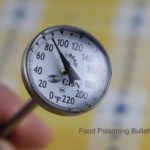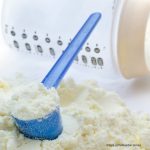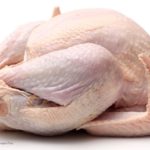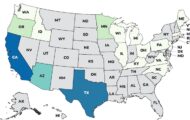Is ground meat safe to eat? With all of the recalls and outbreaks linked to those products, many consumers are asking that question. Consumer Reports conducted a study and found that, in many cases, those products are contaminated with dangerous pathogens including Salmonella and E. coli. The numbers are alarming. Almost a third of the ground chicken packages they tested were contaminated with Salmonella bacteria. And every single strain was resistant to at least one antibiotic, adding to the fear of the development of antibiotic-resistant bacteria. Consumer Reports also found a strain of Shiga toxin-producing E. coli in a sample of ground beef that was so dangerous they alerted the Department of Agriculture, triggering a recall of more than 28,000 pounds of ground beef. Ground … [Read more...]
USDA Adds Possible Beef E. coli O157:H7 Outbreak to Table
The USDA adds a possible beef E. coli O157:H7 outbreak to its Outbreak Investigation Table. The Salmonella outbreak linked to chicken is still on the table. No more information is available about either of these outbreaks. The last outbreak of USDA-regulated foods that was identified and solved was the 2021 Salmonella Hadar outbreak linked to ground turkey that sickened at least 33 people in 14 states and hospitalized four. This outbreak is most likely not linked to ground beef, since the USDA stipulates whether or not the product is ground in its table. Outbreaks associated with whole cuts are not common. The last outbreak linked to whole beef cuts was in 2009, when 21 people in 16 states were sickened with E. coli O157:H7 infections. Beef products from National Steak and … [Read more...]
USDA Offers Tips to Keep Infants Safe While Formula Shortages Exist
The USDA offers tips to keep infants safe while powdered infant formula shortages are ongoing. The shortage is caused by pandemic supply chain issues and the closure of Abbott Nutrition's Sturgis, Michigan plant for environmental Cronobacter contamination. The contamination was discovered during an FDA inspection after reports of infant illnesses. Many parents depend on formula in the first year of a baby's life. Some mothers cannot breastfeed, and some infants require supplemental nutrition or specialty formulas because of medical issues. To keep infants safe, the USDA says parents should not make homemade infant formula. There are serious safety and health concerns related to homemade formula because they can be deficient in nutrients that babies need for health and growth. … [Read more...]
USDA Addresses Powdered Infant Formula Shortage
The USDA has announced that it is addressing the powdered infant formula shortage and is asking states to take advantage of flexibility in the WIC (Women Infants and Children) program. The shortage was caused by pandemic-related supply chain issues and by the closure of Abbott Nutrition's Sturgis, Michigan plant, where Cronobacter was found in environmental samples after complains of infant illnesses. Agriculture Secretary Tom Vilsack said in a statement, "We’re acutely aware that the ongoing recall has left many parents and caregivers concerned about access to formula and how they will feed their babies. Our team is committed to the health and safety of all Americans and is calling on states to act immediately to offer maximum flexibility, information, and support to WIC … [Read more...]
USDA Investigates Possible Chicken Salmonella Enteritidis Outbreak
The USDA is investigating a possible chicken Salmonella Enteritidis outbreak, according to their outbreak investigations response table. This is the first outbreak of a USDA-regulated food for 2022. The table did not give us any more information. We do not know if chicken is the definitive source or what type of chicken it may be, nor do we know how many people may have been sickened. If it is an outbreak, we do not know illness onset dates, where those sickened live, and if anyone has been hospitalized. As far as we know, no recall has been issued. Poultry and Salmonella have caused many outbreaks over the years. It's worth mentioning that Salmonella outbreaks are notoriously underreported. Epidemiologists use a multiplier of 30 to estimate how many people are actually sickened … [Read more...]
Fall Harvested Romaine More Likely to Cause E. coli Outbreaks
Agricultural Research Scientists have found that fall harvested romaine is more likely to contain more E. coli bacteria and cause more outbreaks, according to the USDA. Between 1998 and 2019, there were 36 outbreaks traced back to lettuce, particularly romaine lettuce, that was harvested in the fall on the California Central Coast, and in late winter in Southern California and Arizona. The seasonal outbreaks are more frequently associated with commercially grown lettuce harvested at the end of the growing season. The question is why. ARS microbiologist Maria Brand, leader of the study, said in a statement, "To begin unravelling the causes of these seasonal outbreaks, our research team looked at various factors to identify conditions that may increase E. coli survival on fresh-cut … [Read more...]
USDA Tries to Facilitate Traceability During E. coli Outbreaks
The USDA tries to facilitate traceability during E. coli outbreaks by studying how the DNA of a specific population of this pathogen evolves within its natural environment, according to scientists with the Agricultural Research Service (ARS). The findings from scientists at the U.S. Meat Animal Research Center at Clay Center, Nebraska is giving outbreak investigators information on specific elements of the pathogen's DNA that can narrow where to look for the outbreak source. Scientists analyzed samples collected from the USMARC closed cattle feedlot from 1997 to 2910 and then studied the genomes of different subtypes of E. coli O157:H7 that were found in these samples. Maggie Weinroth, a computational biologist with the Poultry Microbiological Safety and Processing Research Unit … [Read more...]
Slow Cooker Food Safety With Tips From USDA
Learn about slow cooker food safety with tips from the USDA. Slow cookers are appliances that cook food at lower, but still safe, temperatures, for long periods of time. The food heats up quickly enough to stay safe, but cooks long enough to make tougher ingredients such as cheaper cuts of meat and root vegetables tender over time. There are several appliances that function as slow cookers: The traditional slow cooker, the instant pot, and some pressure cookers that have slow-cook functions. While these appliances are easy to use, there are some rules you need to follow to make sure your food is safe to eat. First, if you plan to use frozen meat, seafood, or poultry, do not add it to the slow cooker when frozen. Thaw it first before adding it to the slow cooker. Do not thaw … [Read more...]














